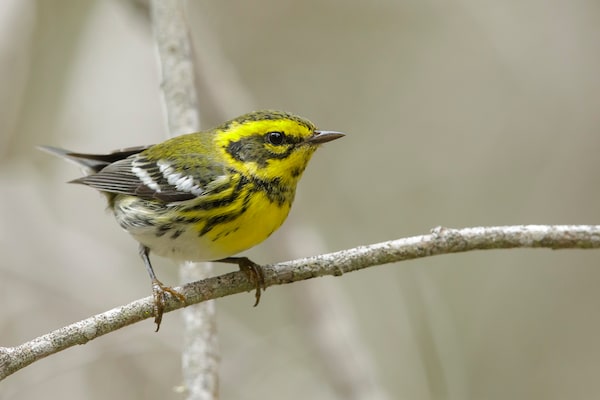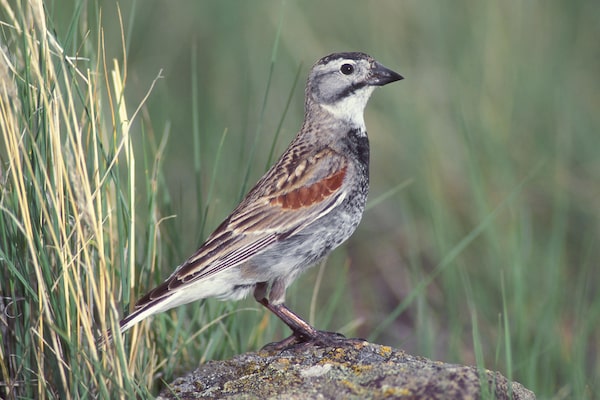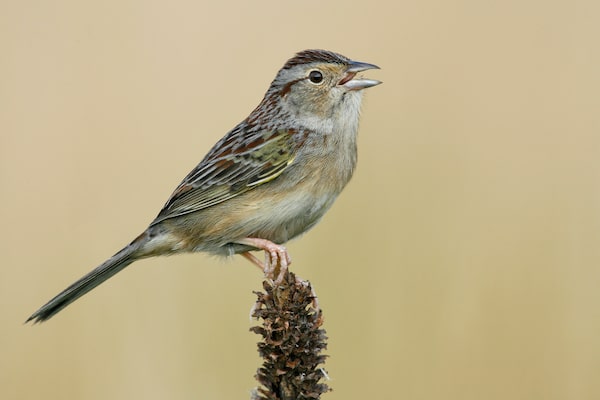Yousif Attia, who runs volunteer programs for Birds Canada, looks through the trees in Vancouver’s Queen Elizabeth Park. 'Each one of these birds is unique. They deserve a name that describes them, not just the dude that shot one,' he says.Alia Youssef/The Globe and Mail
Yousif Attia was out for a bird walk in Richmond, B.C., one day this spring when he heard a subtle but distinctive song coming from the woods: zu-wee, zu-wee, zu-wee. He knew at once it was a Hutton’s vireo, “an awesome little bird” that, in Canada, is found only in southwestern British Columbia.
Mr. Attia posted a video about his find on (where else?) Twitter, but not because the bird is particularly rare. He wanted to talk about its name. The Hutton’s is one of about 150 North American bird species with eponymous names: They are named after a person, often a bewhiskered gentleman from a long-ago era who was the first to shoot and identify one of their number.
The Hutton’s was named after William Hutton, a civil engineer, painter and naturalist who collected specimens of the bird in Monterey, Calif., in 1847. The Audubon Society Encyclopedia of North American Birds calls him “a field collector of birds about whom little is known.” For a long while, even hard-core birdwatchers gave no more thought to him than they did to the Wilson in Wilson’s warbler, the Henslow in Henslow’s sparrow or any of the other half-forgotten humans whose names are attached to birds.
That is starting to change. At a time when North American society is reckoning with historical injustices such as slavery and residential schools, names of all sorts are receiving new scrutiny.
The Edmonton Eskimos have become the Edmonton Elks. Toronto’s Ryerson University is talking about changing its name to remove the association with the 19th-century educator Egerton Ryerson, whose statue was recently toppled from its plinth because of his role in the origins of the residential school system. One of that city’s main thoroughfares, Dundas Street, will be renamed because Scottish politician Henry Dundas is accused of delaying the abolition of the slave trade in the late 18th century. The Entomological Society of America is dropping the name ”gypsy moth” out of consideration for the Romani people.

A Hutton's vireo, or Vireo huttoni.BRIAN E. SMALL / Nature Photographers Ltd / Alamy Stock Photo
Now, bird names are coming under a magnifying glass. Mr. Attia is among a growing number of birders who want to remove eponymous names entirely and give birds names that honour their wonder and beauty rather than commemorate some trigger-happy naturalist. The name of the red-headed woodpecker or the white-winged crossbill tells you something, they argue. That can’t be said for names such as Hutton’s vireo.
“Each one of these birds is unique. They deserve a name that describes them, not just the dude that shot one,” says Mr. Attia, who runs volunteer programs at Birds Canada. He started watching birds as a small boy after his Egyptian family immigrated to Canada from Sudan and settled in Edmonton.
The push to remove eponyms is part of a wider move to make the birdwatching world more inclusive.
That push grew more urgent after a much-publicized incident in New York’s Central Park in May of last year: A white woman called police after a Black man who was out birding asked her to leash her dog. That led, among other efforts, to the founding of Black Birders Week.
Not long after, a pair of Maryland birders, Gabriel Foley and Jordan Rutter, wrote to ask the American Ornithological Society (AOS) to consider changing eponymous names. In an opinion piece in The Washington Post, they said such names serve as “verbal statues” – memorials to a colonial past “that wove the fabric of systemic racism through every aspect of our lives, including the birds we see every day.”

A Townsend's warbler (Setophaga townsendi).Brian E. Small/Getty Images/iStockphoto
On their website, Bird Names for Birds, they note that some of the fellows honoured by bird names are more than just obscure naturalists like Hutton.
John Kirk Townsend has two birds named after him: the Townsend’s warbler and the Townsend’s solitaire. On an expedition to the Pacific Northwest in the 1830s, he studied the region’s birds and mammals. But on other expeditions, he dug up Indigenous burial grounds to collect skulls for a friend who was studying human crania – research that others used to argue that people with German and English background were superior to other races.
The Bachman’s warbler and Bachman’s sparrow are named after John Bachman of Charleston, S.C., a respected Lutheran minister and accomplished naturalist who collaborated with John James Audubon himself. Although he wrote that Black and white people were part of the same, unified human species, he also said Black people were “greatly inferior” to white people and “incapable of self-government.”

A male thick-billed longspur (Calcarius mccownii), formerly the McCown's longspur.BRIAN E. SMALL / Nature Photographers Ltd / Alamy Stock Photo
These uncomfortable facts shook the ornithological establishment. Last year, the North American Classification Committee of the AOS – a sort of Supreme Court of bird disputes – changed McCown’s longspur to the thick-billed longspur, erasing the name of Confederate general John Porter McCown. Now, an ad hoc committee of the society is looking at the whole issue of what the AOS calls “exclusionary or harmful” bird names.
At an online roundtable in April, some of the leading lights of the birding world lent their support to the renaming drive. David Allen Sibley, author of an authoritative series of bird guides, said it is all about respect – not just respect for those hurt by colonialism, but “respect for the birds,” which should “not have to carry a reminder of our own fraught history.”
Another bird-guide author, Kenn Kaufman, said he would feel strange now searching for a Bachman’s sparrow in Georgia with Black friends. Why not just go back to an earlier, more useful name: the pinewoods sparrow?

Bachman's sparrow, or Peucaea aestivalis.Alamy Stock Photo
Not everyone feels the same way. In online comments about the renaming movement, some birders say renaming birds is just another example of political correctness run amok. Others say it opens a can of worms: If we erase eponyms for birds, why not for animals (Blanding’s turtle), plants (Queen Anne’s lace), heavenly bodies (Halley’s comet) or parts of human anatomy (Fallopian tubes)? Where does it end?
Still others say it would throw the system of bird names into chaos, destroying the stability and continuity that comes from having names that everyone knows.
Bird Names for Birds counters that names are always changing anyway. Sometimes, one species is reclassified as two, requiring an extra name. Classifiers change about three names a year.
In 2018, they changed the name of the grey jay to the Canada jay, which it had borne from the 1800s until 1957, and removing what Canadian ornithologists considered a slight to the mischievous bird. Twenty years ago, they gave a new, less offensive name to a duck called the old squaw: the long-tailed duck.
Besides, birds have two kinds of names: the common one (like American robin) and the scientific one (Turdus migratorius). Bird Names for Birds is focusing its campaign on the common names. For now at least, Hutton’s vireo would stay Vireo huttoni.
If all this fails to persuade, Bird Names has another argument. “If we could just say right now we’re going to do this,” Ms. Rutter says, “think of how fun it would be to think of new names.”

A gorgeous bush shrike (Telophorus viridis).Dubi Shapiro/Getty Images/iStockphoto
The bird world already has some corkers: the superb fairy-wren of Australia, the gorgeous bush shrike of Africa, the sombre tit of Europe and Asia, the red-rumped bush-tyrant of South America, the diabolical nightjar of Southeast Asia.
Vancouver’s Mr. Attia has a more modest idea for the Hutton’s vireo, the one he saw on his bird walk. The tiny songbird bears an almost spooky resemblance to a species from a whole different group: the ruby-crowned kinglet. Easy, then: kinglet vireo.
That would give a handy hint to novice birders (it’s that one that looks just like a kinglet) – and the more birders the better. A 2019 report found that North America had lost about three billion birds since 1970, about a quarter of their number. As Mr. Attia puts it: “Anything we can do to help people care about birds is a step in the right direction.”
Yousif Attia continues his bird walk in Queen Elizabeth Park.Alia Youssef/The Globe and Mail
 Marcus Gee
Marcus Gee